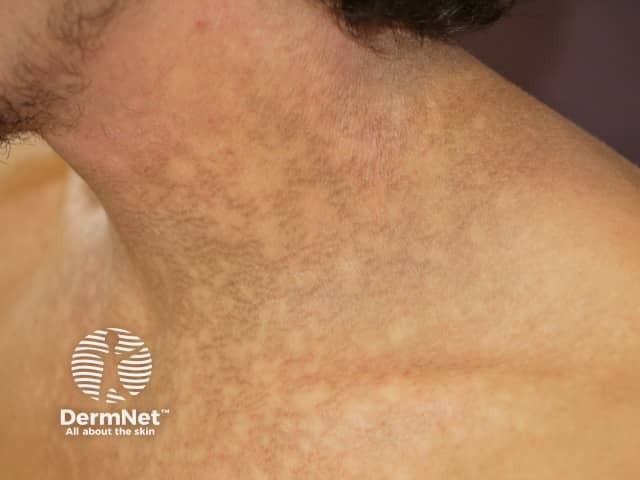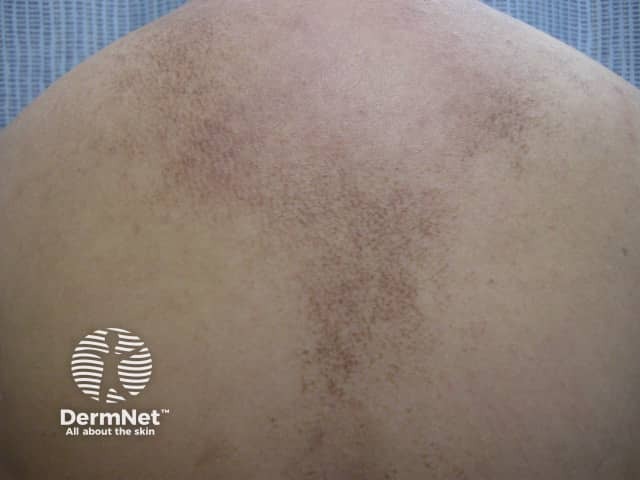Main menu
Common skin conditions

NEWS
Join DermNet PRO
Read more
Quick links
Author: Vanessa Ngan, Staff Writer, 2005. Latest update Dr Thomas Stewart. DermNet Editor in Chief: A/Prof Amanda Oakley, Dermatologist, Hamilton, New Zealand. Copy edited by Gus Mitchell. April 2018.
Introduction Demographics Causes Clinical features Differential diagnoses Diagnosis Treatment Outlook
Confluent and reticulated papillomatosis is an uncommon skin condition affecting the trunk, neck and axillae. It is characterised by asymptomatic, hyperpigmented papules and plaques that have a peripheral, net-like configuration.
French dermatologists Gourgerot and Carteaud first described confluent and reticulated papillomatosis in 1927 [1].

Confluent and reticulated papillomatosis

Confluent and reticulated papillomatosis

Confluent and reticulated papillomatosis
Confluent and reticulated papillomatosis mostly occurs in young adults. The mean age of incidence is 15 years, with a range of 8–32 years [2]. It has been reported worldwide in all racial groups and ethnicities, but it is reported to be most common in Caucasians [3].
What triggers confluent and reticulated papillomatosis remains unclear. Disordered and hyperproliferative keratinisation has been observed on light and electron microscopy [4,5]. The possibility that this is due to skin infection is supported by the success of treatment with antibiotics.
Genetic factors may also be involved.
Insulin resistance, which causes diabetes mellitus and polycystic ovarian syndrome, has been suggested as a contributing factor to confluent and reticulated papillomatosis, but evidence is weak, as most affected patients do not have metabolic syndrome [12,13].
Amyloidosis and reaction to ultraviolet light have also been considered but are unlikely causes [14,15].
Confluent and reticulated papillomatosis is characterised by multiple 1–5 mm, hyperpigmented, scaly macules or papillomatous papules.
The most common conditions that mimic the morphology and/or distribution of confluent and reticulated papillomatosis are:
Less common disorders that may need to be considered in the differential include:
The diagnosis of confluent and reticulated papillomatosis is based on identifying typical clinical features and excluding fungal infection by microscopy and culture of scale (see mycology of dermatophyte infections).
Davis et al have proposed a set of diagnostic criteria for confluent and reticulated papillomatosis [2].
This set of criteria has shown good concordance with other large case series [19].
Skin biopsy may be indicated to exclude other diagnoses.
Confluent and reticulated papillomatosis usually clears with a tetracycline (minocycline, doxycycline for 6–12 weeks) or a macrolide antibiotic (azithromycin, clarithromycin, erythromycin for 4–6 weeks) [2,20,21]. Azithromycin and erythromycin can be prescribed in pregnancy [22–24]
Topical tazarotene (a topical retinoid), tacrolimus and calcipotriol may be used for localised disease [25–27].
Systematic retinoids (isotretinoin and acitretin) are usually reserved for cases refractory to antibiotics and topical agents [28].
A single course of minocycline or a macrolide antibiotic is reported to lead to remission for up to 2 years in many cases of confluent and reticulated papillomatosis [2,21,29].
Recurrence in up to 15% of cases usually follows non-antibacterial treatment.
Spontaneous resolution has been reported in a few cases but it may take up to 39 months for the eruption to clear up [30].